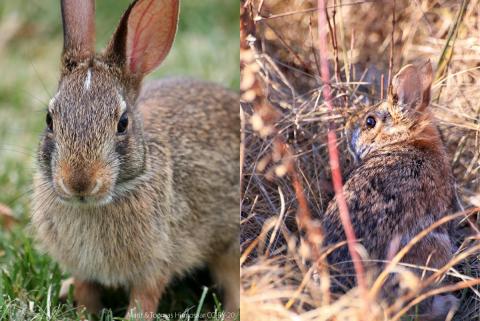There are two species of rabbits in New Hampshire, the eastern cottontail and the New England cottontail. The eastern cottontail is not native east of the Hudson River and was introduced to New England in the early 1900s as a game species. The New England cottontail is native to the region but has seen dwindling population numbers over the last several decades throughout its range, mostly due to habitat loss and fragmentation, and is currently listed as a state-endangered species in New Hampshire.
Look-a-likes
Despite the fact that they are separate species, the New England cottontail and eastern cottontail are nearly identical in appearance. Both have a grayish brown pelt flecked with black, and a white tail, but there can be some subtle physical differences. Most New England cottontails have a small black spot on the forehead, whereas about half of all eastern cottontails have a white spot in the same place. The New England cottontail's ears are slightly shorter than those of the eastern cottontail and have a line of black fur along the outer edge. However, without being able to make a direct comparison and given the variation in individuals, it is not always possible to identify the species based on sight alone.

Eastern cottontails (left) and New England cottontails are nearly identical, but are separate species and do not interbreed.
Additionally, the larger snowshoe hare also inhabits New Hampshire. This species’ fur turns white in the winter, allowing it to blend into the snow-covered landscape, while the fur of cottontail rabbits stays brown year-round. Despite this seasonal difference, visual identification can still be difficult during the summer months depending on the distance, angle of the sighting, and experience of the reporter.
For tips on how to take a photo of a rabbit that provides the best chance for identifying the species, visit the Tips for Photographing Rabbits page.
Confirming a Cottontail’s Presence
In order to confirm an identification of either New England cottontail or eastern cottontail, a scientist may examine a specimen’s skull shape (which differ between the two species) or analyze DNA extracted from body tissues or droppings. In New Hampshire, DNA analysis of fecal pellets collected during winter surveys is the method most often used to determine the presence of New England cottontails or eastern cottontails in a given area. To date, NH Fish and Game has coordinated a comprehensive effort to determine the presence of New England cottontail rabbits within the Merrimack Valley and Seacoast focus areas, and are conducted by wildlife biologists, graduate students, and volunteers. Less is known about the distribution and relative abundance of eastern cottontails and in 2016, volunteer survey efforts were expanded beyond New England cottontail focus areas to include areas on the perimeter where it’s unknown one or both species are present and in what numbers. Sightings reported to the NH Rabbit Reports website will help contribute to this work in order to better understand the distribution of cottontail rabbits, specifically eastern cottontails, in New Hampshire.
Competing Cottontails
Eastern cottontails and New England cottontails do not interbreed or hybridize in the wild, but they may compete for habitat. Biologists believe that larger eyes and sharper vision lets eastern cottontails venture farther from protective cover while remaining able to spot and evade predators, so are better able to survive in fragmented, human-dominated landscapes. In many small habitat patches, eastern cottontails have replaced New England cottontails. They likely do not directly oust New England cottontails from such areas, but may simply be able to survive in habitats that New England cottontails cannot use. They may also be better able to find and occupy new habitats as they become available. Understanding the relationship between the distributions of these two rabbit species is important in order to make informed decisions about where habitat management will be most effective for New England cottontail.

